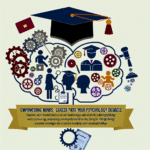
Introduction
In today’s multifaceted educational landscape, understanding each student’s unique needs goes beyond the four walls of the classroom. The concept of Response to Intervention (RTI) has emerged as a significant framework designed to help educators identify and support diverse learners effectively. It’s not merely an intervention strategy; it’s a holistic approach that lays the groundwork for success in all areas of a child’s life. As educators, parents, and communities unite to advocate for more inclusive practices, it’s imperative to examine Beyond the Classroom: The Role of RTI in Supporting Diverse Learners.
The Shift in Educational Paradigms
Traditionally, education relied heavily on a one-size-fits-all model. Students who didn’t fit this mold often fell through the cracks, leading to frustration for educators and learners alike. However, the RTI framework promotes an inclusive, personalized approach, extending the support system far beyond conventional teaching methods. This article explores how RTI empowers educators, engages families, and supports diverse learners—transforming challenges into opportunities.
What is RTI?
Response to Intervention (RTI) is an educational strategy that combines both assessment and intervention to support all students, especially those with diverse learning needs. It integrates a tiered approach consisting of three levels of increasingly intensive interventions:
Tier 1: Universal Interventions – High-quality instruction and screening for all students in the general education classroom.
Tier 2: Targeted Interventions – Smaller group interventions for students who require more support than what Tier 1 offers.
- Tier 3: Intensive Interventions – Individualized programs for students with significant difficulties, often leading to special education referrals.
This model encourages early identification and intervention, thereby reducing long-term academic struggles.
The Importance of Data-Driven Decision Making
Data plays a crucial role in the RTI framework. By regularly assessing student performance—through both formative and summative assessments—educators can make informed decisions regarding interventions. This data-driven approach cultivates an environment that values continuous improvement, ensuring that every student has an equal opportunity to succeed.
Table 1: RTI Framework Summary
| Tier | Focus | Instruction Type | Frequency of Assessment |
|---|---|---|---|
| Tier 1 | All students | Universal instruction | Regular classroom assessments |
| Tier 2 | At-risk students | Targeted group instruction | More frequent progress monitoring |
| Tier 3 | Students with intensive needs | Individualized instruction | Continuous monitoring |
Understanding Diverse Learners
Diverse learners encompass a broad spectrum of students, including those with disabilities, language barriers, and varying cultural backgrounds. Understanding these diverse backgrounds is key to tailoring interventions effectively.
Case Study: Maria’s Journey
Maria, a third-grade student with limited English proficiency, struggled to keep up academically. Her teacher, implementing RTI, noticed her difficulties with reading comprehension. After assessing Maria using both formal tests and informal observations, the school provided targeted small-group instruction focused on vocabulary development.
As a result, Maria’s reading skills improved significantly within just a few months. This case illustrates the effective use of RTI and its capacity to support diverse learners with tailored interventions, highlighting the framework’s core value: addressing individual needs.
Building Collaborative Partnerships
The Role of Educators
Educators are the backbone of the RTI process. This framework encourages collaboration among teachers, specialists, and families. Through consistent communication and shared knowledge, educators can create a support network focused on student success.
Engaging Families
Family involvement is another principal element of RTI. Educators need to communicate clearly and effectively with families to foster understanding and partnership. Feedback from families provides valuable insights into students’ lives outside the classroom, enhancing the overall approach to intervention.
RTI and Social-Emotional Support
An equally important aspect of RTI is addressing the social-emotional needs of diverse learners. Understanding that education is not solely about academics allows educators to nurture the whole child, promoting emotional resilience, critical thinking, and well-being.
Case Study: The Holistic Approach
In a school district that implemented RTI, a teacher noticed an uptick in behavioral issues among students. They adjusted their RTI strategy to include social-emotional learning (SEL) alongside academic interventions.
The results were transformative: students reported feeling more connected to their peers and teachers, leading to improved academic outcomes. This case highlights Beyond the Classroom: The Role of RTI in Supporting Diverse Learners, showcasing the importance of addressing both academic and emotional needs.
Professional Development for Educators
Professional development is critical for teachers implementing RTI effectively. Training sessions that focus on differentiated instruction, cultural competency, and data analysis empower educators to employ RTI successfully.
The Future of RTI
As educational paradigms continue to evolve, the RTI framework will likely adjust to meet the needs of future learners. Innovations in technology, assessment, and pedagogy will shape how we understand and implement RTI. It is vital for educators to stay well-informed, agile, and responsive to these changes.
Conclusion
Beyond the Classroom: The Role of RTI in Supporting Diverse Learners is not merely a concept but a powerful movement towards inclusivity in education. By valuing data-driven decision-making, fostering collaboration among educators and families, and addressing both academic and social-emotional needs, RTI creates pathways for all learners to thrive.
It is our collective responsibility to champion a truly inclusive educational environment, where every child finds their place and flourishes. Let us embrace the role of RTI as a transformative strategy that extends beyond academic barriers, ensuring that diversity is celebrated, understood, and nurtured.
FAQs
1. What is the primary goal of RTI?
The main goal of RTI is to identify struggling students early and provide targeted support to help them succeed in their academic endeavors.
2. How does RTI differ from traditional special education?
Unlike traditional special education, RTI focuses on early intervention within the general education classroom, providing tiered support before considering special education placement.
3. Can RTI be used for all students, not just those with learning disabilities?
Absolutely! RTI is designed for all learners and is especially beneficial for students who are at risk of academic failure due to various reasons, including language barriers and socio-emotional issues.
4. How can I support my child’s learning through the RTI process?
Engaging with educators and staying informed about your child’s progress is essential. Attend meetings, ask questions, and collaborate on strategies for home support.
5. Is RTI a one-size-fits-all solution?
No, RTI is inherently flexible. It can and should be tailored to meet the individual needs of each student, ensuring that diverse learners receive the specific support they require.
By implementing the principles of RTI, we equip educators to transform challenges into empowering experiences that lead to lifelong success for diverse learners inside and beyond the classroom.

















